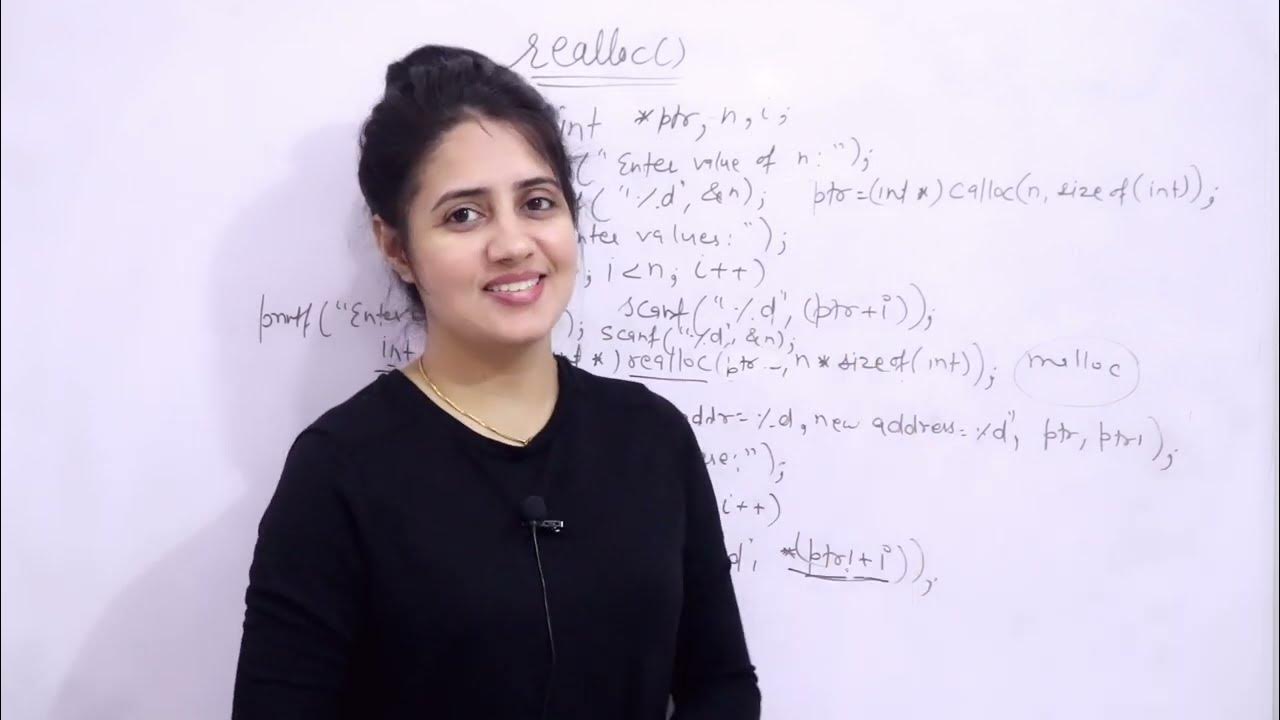C_133 Dynamic Memory Allocation using malloc() | C Language Tutorials
Summary
TLDRIn this video, the instructor explains dynamic memory allocation in C, specifically focusing on the `malloc` function. The video covers the concept of dynamically allocating memory from the heap, the general syntax of `malloc`, and how it returns a void pointer. The instructor emphasizes the importance of typecasting and using pointers to manage dynamically allocated memory. Practical examples are provided, along with a C program that demonstrates how to use `malloc` to allocate memory for integer values entered by the user. The video also briefly touches on potential issues like memory allocation failure and the need to free allocated memory using the `free` function.
Takeaways
- 😀 Dynamic memory allocation in C is managed using functions like `malloc`, which allocate memory during runtime.
- 😀 The `malloc` function has the syntax `malloc(size_t size)` and returns a `void*` pointer, which can be typecast to any pointer type.
- 😀 `malloc` is used to allocate memory on the heap, as opposed to the stack, for dynamic and flexible memory management.
- 😀 A key point of `malloc` is that it helps prevent memory wastage by allocating memory based on runtime requirements.
- 😀 It's important to always check if the `malloc` function returns `NULL`, indicating that the memory allocation failed.
- 😀 In case of failure, it's crucial to handle the `NULL` value to prevent accessing invalid memory.
- 😀 The `malloc` function doesn't initialize the allocated memory, which means the content of the allocated memory could be random values until explicitly initialized.
- 😀 Proper memory management using `malloc` can help create programs that are more efficient in terms of memory usage, especially for large data structures.
- 😀 The video gives an example of dynamically allocating memory for integers and storing user input using pointers.
- 😀 Understanding `malloc` is essential for managing memory effectively in C, ensuring that your programs are both resource-efficient and bug-free.
Q & A
What is dynamic memory allocation in C?
-Dynamic memory allocation in C refers to the process of allocating memory during the runtime of the program, rather than at compile time. This is done using functions like malloc, calloc, realloc, and free.
What is the purpose of the malloc function in C?
-The malloc function in C is used to allocate a block of memory on the heap at runtime. It returns a pointer to the allocated memory or NULL if the allocation fails.
What does malloc return, and how should it be used?
-malloc returns a void pointer, which can be cast to any specific pointer type (like int*, float*, etc.) depending on the data being stored. The returned pointer can then be used to store and access data in the allocated memory.
How does the size of the allocation in malloc work?
-The size parameter in malloc specifies the number of bytes to allocate. To allocate memory for an array, the size of a single element is multiplied by the number of elements you want to store (e.g., 3 * sizeof(int) for an array of 3 integers).
What happens if malloc fails to allocate memory?
-If malloc fails to allocate memory, it returns NULL. It's essential to check whether the pointer returned by malloc is NULL to handle memory allocation failures appropriately.
Why is typecasting necessary when using malloc?
-Typecasting is necessary because malloc returns a void pointer, which can point to any data type. To use it for specific types of data (like integers or floats), you need to typecast it to the appropriate pointer type.
What is the difference between malloc and calloc?
-Both malloc and calloc allocate memory dynamically, but the key difference is that malloc does not initialize the allocated memory (it contains garbage values), whereas calloc initializes the allocated memory to zero.
How do you free memory allocated by malloc?
-To free memory allocated by malloc, use the free function. The syntax is `free(ptr);` where `ptr` is the pointer to the allocated memory. This ensures that the memory is returned to the system and prevents memory leaks.
What is the role of the heap in dynamic memory allocation?
-In dynamic memory allocation, memory is allocated on the heap, which is a portion of memory used for variables whose size is determined at runtime. This contrasts with the stack, where memory is allocated for local variables during function calls.
What are the risks of not freeing dynamically allocated memory?
-Not freeing dynamically allocated memory can lead to memory leaks, where memory that is no longer needed is not returned to the system. Over time, this can cause a program to consume more memory than necessary, leading to performance issues and potential system crashes.
Outlines

هذا القسم متوفر فقط للمشتركين. يرجى الترقية للوصول إلى هذه الميزة.
قم بالترقية الآنMindmap

هذا القسم متوفر فقط للمشتركين. يرجى الترقية للوصول إلى هذه الميزة.
قم بالترقية الآنKeywords

هذا القسم متوفر فقط للمشتركين. يرجى الترقية للوصول إلى هذه الميزة.
قم بالترقية الآنHighlights

هذا القسم متوفر فقط للمشتركين. يرجى الترقية للوصول إلى هذه الميزة.
قم بالترقية الآنTranscripts

هذا القسم متوفر فقط للمشتركين. يرجى الترقية للوصول إلى هذه الميزة.
قم بالترقية الآنتصفح المزيد من مقاطع الفيديو ذات الصلة

C_135 Dynamic Memory Allocation using realloc() | C Language Tutorials

C_132 Introduction to Dynamic Memory Allocation in C | SMA vs DMA

C_134 Dynamic Memory Allocation using calloc() | C Language Tutorials

Dynamic Memory Allocation In C | C Memory Management Explained | C For Beginners | Simplilearn

EDB1 IMD UFRN : Alocação Dinâmica de Memória e Ponteiros

Understanding the Void Pointers
5.0 / 5 (0 votes)
